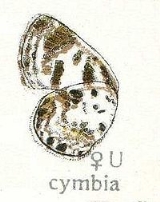
Niphanda cymbia
Encyclopedia
The Pointed Pierrot is a small butterfly
found in India
that belongs to the Lycaenids or Blues
family.
Female upperside: brown. Fore wing: the costal and terminal margins, and tho area below the basal half of the cell of a darker brown than the ground-colour; an irregular transverse posterior discal series of dark brown spots, between which and the dark basal area on the inner side and between it and the broad dark terminal band on the outer side the ground-colour is replaced by dingy white. Hind wing: a post-discal series of white spots, and a subterminal series of inwardly conical very dark brown spots, the posterior spots of which are edged narrowly both on the inner and outer sides with white. Both fore and hind wings with slender black anticiliary lines. Underside: ground-colour a purer white than in the male; markings similar but all narrower and more clearly defined. Antennae, head, thorax and abdomen brown, of a paler shade than in the male the thorax not purplish; beneath: palpi, thorax and abdomen white.
Butterfly
A butterfly is a mainly day-flying insect of the order Lepidoptera, which includes the butterflies and moths. Like other holometabolous insects, the butterfly's life cycle consists of four parts: egg, larva, pupa and adult. Most species are diurnal. Butterflies have large, often brightly coloured...
found in India
India
India , officially the Republic of India , is a country in South Asia. It is the seventh-largest country by geographical area, the second-most populous country with over 1.2 billion people, and the most populous democracy in the world...
that belongs to the Lycaenids or Blues
Lycaenidae
The Lycaenidae are the second-largest family of butterflies, with about 6000 species worldwide, whose members are also called gossamer-winged butterflies...
family.
Description
Male Upperride: violet with a brilliant effulgence in fresh specimens, fore wing: costa and termen narrowly edged with dark brown, a dark brown transverse short streak also on the discocellulars. Hind wing: costa, termen and discocellulars marked as in the fore wing, but the dark brown edging slightly broader, on the termen it is produced obscurely inwards in the posterior interspaces ; dorsum somewhat broadly dusky brown. Underside: dull whitish, JFore wing: basal half of costs shaded with brown; a streak from base between vein 12 and the subcostal vein, an inwardly oblique, very broad, lunular subbasal spot, a spot on the discocellulars, a transverse discal band, a transverse subterminal series of inwardly conical spots and a slender anticiliary line, dark brown; the transverse discal band is maculate and broken, its anterior portion to vein 3 outwardly oblique, its posterior portion below vein 3 shifted well inwards and nearly vertical; the costa above vein 12, a postdiscal transverse irregular cloud very broad anteriorly, narrow and faint posteriorly, and a transverse inner sub-terminal lunular line, pale brown. Hind wing: the humeral edge of the precostal area, two or three basal spots, a transverse subbasal line of four spots, a transverse spot on the discocellulars, with above it in vertical order two coalescent spots, a transverse curved macular discal band, an inner, subterminal, lunular, continuous broad band, a subterminal series of spots and an anticiliary line, brown; the basal and subbasal markings, the anterior of the two spots above the discocellular spot, and the posterior four subterminal spots very dark brown, almost black. The discal band has on either side of it posterior shorter macular bands, that give it an irregular and ill-defined appearance, wlnle the two spots nearest the costa of the inner markings are very large and prominent. Cilia of both fore and hind wings brown. Antennae, head, thorax and abdomen brown, the thorax slightly purplish in fresh specimens, the shafts of the antennae ringed with white; beneath: palpi, thorax and abdomen dingy brownish-white.Female upperside: brown. Fore wing: the costal and terminal margins, and tho area below the basal half of the cell of a darker brown than the ground-colour; an irregular transverse posterior discal series of dark brown spots, between which and the dark basal area on the inner side and between it and the broad dark terminal band on the outer side the ground-colour is replaced by dingy white. Hind wing: a post-discal series of white spots, and a subterminal series of inwardly conical very dark brown spots, the posterior spots of which are edged narrowly both on the inner and outer sides with white. Both fore and hind wings with slender black anticiliary lines. Underside: ground-colour a purer white than in the male; markings similar but all narrower and more clearly defined. Antennae, head, thorax and abdomen brown, of a paler shade than in the male the thorax not purplish; beneath: palpi, thorax and abdomen white.

